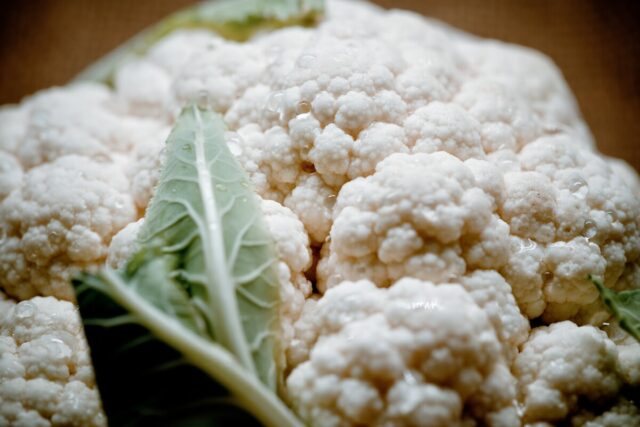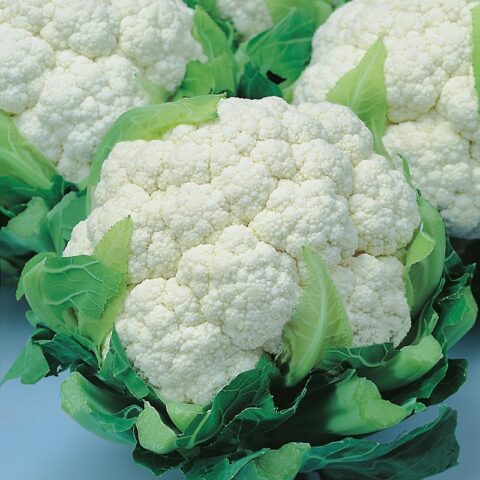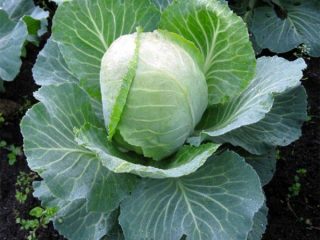Content
Varieties of cauliflower differ in the color of the heads, the shape of the leaves and the ripening period. They are chosen for planting taking into account the climate of the area, so that the plant does not die in early spring from a sharp drop in temperature and has time to ripen before the onset of frost. A review of the most popular varieties of cauliflower with names and photos will help you choose the best option for a particular region.
Early varieties of cauliflower
A crop is considered early ripening if it manages to fully ripen in 75-110 days. This is an ideal option for temperate climates and Siberian regions, where summers are short but optimally warm for cauliflower. Varieties develop better in high humidity and not very hot weather. In the South, it is better to plant these varieties of cauliflower in partial shade on moderately moist soil.

Early representatives form less green mass and their heads are smaller than those of later ones
The shelf life of early ripening specimens is short, but the vitamin composition and amount of minerals is much higher.
Guarantee
Cauliflower Garantiia is one of the earliest varieties of domestic selection. The crop has been grown for more than 50 years. Ripens on average in 90 days. The head weighs 400-800 g with a fine-grained surface, rounded-flattened, white with a slight creamy tint.

The head of cabbage is half-open, grows without additional measures in temperate climates, requires shading in subtropical climates
Dereza goat
Goat Dereza is a super early variety; cauliflower is harvested in 1.5-2 months. In cooking, not only the head of cabbage is used, but also the green mass. The rosette of the variety is compact, the leaves are elongated, with carved edges, and bluish-green. The head is convex, round, white, dense, does not fall apart, weighing up to 800 g.

Fruiting in the Goat-wolfberry is stable, ripening is simultaneous
Snowball
Snowball is one of the ultra-early varieties; cauliflower ripens in 2.5 months from the moment the seeds germinate. The head is dome-shaped, with a coarsely bumpy surface, white. Average weight - 800 g. When applying fertilizers during the tying period, the fork can reach up to 1.2 kg. The rosette is narrow, the leaf blades are medium-sized, light green with a bluish tint.

Snowball cauliflower is grown in regions with temperate continental and subtropical climates
From 1 m² you get 3 kg of harvest.
Movir 74
Movir 74 (Movir) is a hybrid variety of the crop, ripens in 100 days.To get a good harvest in a timely manner, it is better to sow the Movir variety in early spring under a film in open ground, then place the cauliflower in the garden at the three-leaf stage. The hybrid will undergo natural hardening and will not painfully adapt to a new place. The plant is medium-sized, suitable for mechanized harvesting, therefore it is grown on an industrial scale. Head up to 1.4 kg, round, with a coarse-grained surface, white.

Fork Movir 74 is covered with leaves, does not require additional shading, dense, juicy
Francoise
Françoise is a productive, early variety with a large head. Ripens in 90 days, cauliflower requires light, and thanks to the central part covered with leaves, it does not suffer from excess ultraviolet radiation. Forms round, irregularly shaped forks with a coarsely bumpy surface. The color is white, the structure is juicy, there is no bitterness in the taste, it weighs up to 1.5 kg.
In order for the plant to form large plugs, cobalt and boron are needed. For feeding, choose a mineral fertilizer that contains these microelements.

From 1 m2 up to 8 kg or more of Françoise's crop is harvested
Mid-season varieties
Average representatives of cauliflower are classified into three categories. Mid-early - ready for harvesting in 120-130 days. Mid-ripening - fruits reach biological ripeness at 140 days. Medium late - harvested after 150 days. The dates are tentative and may change depending on the weather. A review of the best varieties of cauliflower will help you choose varieties for cultivation in open ground.
Parisian
Parisian is a hybrid form of culture with immunity to infections and pests. Adapts well to any climate zone.Ripens in 125 days.
Characteristic:
- rosette slightly spreading, core half-closed;
- the leaves are long (up to 40 cm), elliptical, light green with a blue bloom;
- fork weight – 2-2.2 kg;
- the surface of the fruit is coarsely lumpy, light cream;
- the structure is dense, does not fall apart, juicy;
- The taste is balanced, the presence of bitterness is minimal.
The Parisian is well stored and transportable.

Subject to the conditions of agricultural technology, optimal watering and full application of fertilizers, up to 8 kg of crop can be harvested from 1 m2
Snowdrift
Snowdrift is a mid-early representative, matures in 115-120 days, light-loving. The head is completely covered with leaves, so this variety is cultivated only in an open area.
What does cauliflower look like:
- the heads are cylindrical, dense with pronounced tuberosity;
- the color is milky white, the structure of the fruit is juicy and tender;
- taste due to a high concentration of vitamin C with a slight sourness;
- fork weight – up to 700 g;
- The rosette is powerful, compact, the leaves are erect;
- the plates are narrow, long, dark green.
Productivity is unstable, in warm summers it reaches 4.5 kg. In cold and rainy weather, small heads are formed; no more than 2 kg per 1 square meter is collected. m.

Snowdrift is a type of universal use; all vegetative parts are used in cooking
Summer resident
Dacha (Dachnitsa) is an ideal cauliflower for a remote summer cottage. The variety is undemanding to care and heat-resistant. Reacts calmly to low temperatures and sudden changes. It begins to ripen unevenly on the 115th day, fruiting is extended over 10-14 days. In general from 1 m2 take up to 3 kg.
What it looks like:
- the bush is tall, powerful, with a long taproot;
- the rosette is spreading, the fruit is half-closed;
- head weighing up to 550 kg, white-pink, dense, with a fine-grained surface.
Taste with a slight presence of bitterness.

The Dachnitsa variety is used in cooking and for preservation; cauliflower does not lose its beneficial composition after freezing.
Romanesco
Romanesco is a hybrid with a decorative-looking head. The shape of the fork is cone-shaped, reminiscent of broccoli, olive-colored, weighing more than 2 kg. The leaves are narrow, long, with a blue tint. Classified as a mid-early variety, it ripens simultaneously in 110-120 days. Productivity is stable from 1 m2 take up to 6 kg.
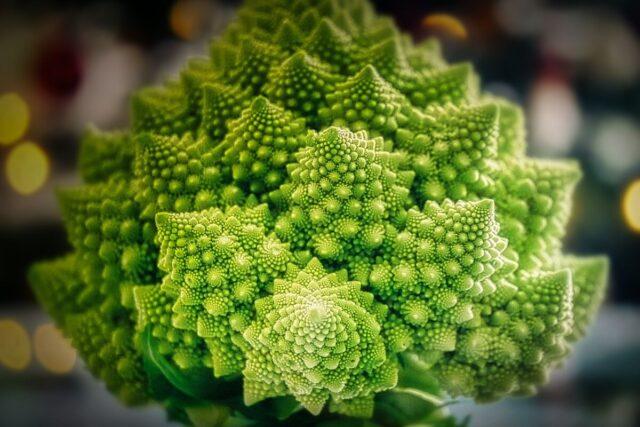
Romanesco fully bears fruit in the Central, Middle zone, South and temperate continental climates and is grown in greenhouses
Fremont F1
Fremont is one of the large-fruited hybrids with a self-covering head. Light-loving cauliflower reacts negatively to a lack of ultraviolet radiation. With proper placement on the site, constant watering and timely feeding of the forks, it grows up to 3 kg, which is a record figure for the crop.
What it looks like:
- the bush is powerful, with a dense rosette;
- central wide leaves are erect, lateral drooping;
- forks rounded-flattened, lumpy, with a fine-grained surface, light beige.
There is slight acidity and bitterness in the taste.

Ripens in 120 days, yield is up to 9 kg per 1 m2
Late varieties of cauliflower
Late-ripening representatives include varieties in which the fruits ripen from 160 days or later. Such varieties are not suitable for open ground in Siberia or the Urals. The forks do not have time to reach biological ripeness before the onset of frost. Can be grown with shelter at night in the fall. Late cauliflower is especially popular in the middle zone, in the South and in the Moscow region.A review of popular late-ripening varieties of cauliflower will help you choose the optimal variety.
Cabbage Incline
Incline is a late-ripening variety of colored crop with a long ripening period. The first forks are cut at the end of August, the last - in the second half of September. The heads are round, finely tuberous, white, and do not turn yellow after full ripening. The mass is not the same. On nearby bushes the difference is from 1.5 kg to 2.5 kg. The leaves are ellipsoid, dark green, with a matte sheen, the structure is rigid.

Incline's yield is unstable, up to 7 kg is taken from 1 m2
Variety – Skywalker
Skywalker is a late hybrid. Ripens quickly in 5.5 months. The bush is low, compact and does not take up much space; it is a priority for farmers. Heat-resistant, not demanding on watering. The heads are half-covered by leaves, so the variety is not afraid of direct rays of the sun.
What it looks like:
- the rosette is dense, formed from leaves of medium length and width;
- the plates are hard, dark green, with a matte gloss; they are practically not used in cooking;
- the head of cabbage is milky white, irregularly rounded, with clearly defined tubercles;
- the structure is juicy with high gastronomic characteristics.

The weight of the Skywalker head is within 2.3 kg, productivity per 1 m2 is 6 kg
Agnia
Agnia is an average late variety. Ripens within 110 days after placing the seedlings in the garden. Fruits weighing up to 1.5 kg, roundly flat, white, with a creamy tint, finely lumpy, dense. The variety is unpretentious to the composition of the soil, but requires constant watering and shading of the ovaries. The rosette is spreading, the leaves are large, the outer leaves are located at right angles.

The productivity of Agnia is stable, but due to the powerful spreading green mass, no more than 3 kg is removed from 1 m2
Green snowdrift
Green snowdrift is a new product of domestic selection. The variety is intended for cultivation in the regions of the North Caucasus. The fruits ripen in 180-190 days. Valued for its unusual soft green color of the head and high nutritional value.
Characteristic:
- the head of cabbage is round, finely tuberous, weighing up to 800 g;
- the structure of the head is juicy, without acid and bitterness;
- a bush with a narrow rosette formed by large leaves of a soft blue color with a grayish tint.
The conditions of the variety's agricultural technology include mandatory shading of the head of cabbage.

Productivity of cauliflower Green snowdrift - up to 4 kg per 1m2
Russian size
Russian size is one of the common varieties of late cauliflower in temperate climates. The heads ripen in 130 days. The variety received its varietal name due to the mass of the heads of cabbage; they can grow weighing more than 4 kg. The shape of the head is flat-round, with protruding large tubercles, white.

Variety Russian size is universal in use and stores well
The best varieties of Dutch cauliflower selection
Mostly hybrids come from Holland to the domestic seed market. They are adapted to temperate climates and also feel comfortable in hotter regions. Cauliflower is characterized by stable fruiting and is not afraid of low temperatures or sudden changes. Characterized by strong immunity.
Common varieties:
- Vinson is an early hybrid with large, bumpy milky heads.The weight of heads of cabbage averages up to 3 kg.
- White perfection - heads with good self-covering leaves, snow-white, with a fine-grained surface, very dense. Fruit weight is 0.8-1 kg.
- Snowball – the heads of cabbage are medium-lumpy, dense, with a creamy tint. Weight – up to 2 kg. The variety is cold-resistant, seedlings can easily tolerate temperatures down to -2 without shelter.0C.
- Flora Blanca is a mid-early variety. The ripening period is 120 days. The head of cabbage is coarsely lumpy, light cream, weight – 1.3 kg. The bush is spreading, powerful, 1 m2 more than two seedlings are not placed.
- Freedom is one of the stress-resistant, mid-season representatives with a white, dense, lumpy head of cabbage. Weight on average up to 2.5 kg.
The line of Dutch selection is represented mainly by early and middle varieties, among them there are ultra-early representatives of cauliflower, which take two months to ripen. The only disadvantage of the varieties is the impossibility of propagation by collected seeds. Seedlings of the second generation do not retain the biological characteristics of the parent plant.
Varieties of the largest cauliflower
The standard weight of representatives of the crop is up to 1.3 kg; this category mainly includes varieties of cauliflower; hybrids form large fruits, their weight is 2 kg or more.
The largest include:
- Whiteaxel is an ultra-early, white-fruited, self-covering hybrid of a colored crop. Grows up to 2.8 kg.
- Candide Sharm is an early-ripening representative of the Japanese selection with a snow-white, dense head of cabbage. Weight – 3-3.2 kg.
- Cortez - mid-early, fastidious, grows only on soil well enriched with minerals.When the conditions are met, it forms a coarse, milky-colored head. One of the large-fruited representatives of cauliflower, weighing more than 3 kg.244. Ferrara - with a slightly pronounced tuberosity on the surface of dense snow-white heads of cabbage. One of the ultra-early varieties of cauliflower. Minimum weight – 2.3 kg.
- Prudence is an ideal white-fruited variety for temperate climates. Forms heads of at least 2.5 kg
Types of decorative cauliflower
Cauliflower comes in yellow, blue, green, purple and other varieties with mixed colors. The variety of exotic shapes also attracts attention. The crop is grown not only for culinary use, but more often as a landscape design option.
Below in the pictures with the name of the species are presented the most exotic representatives of decorative cauliflower.

Clara's corals

Yarik

Verdant

Graffiti
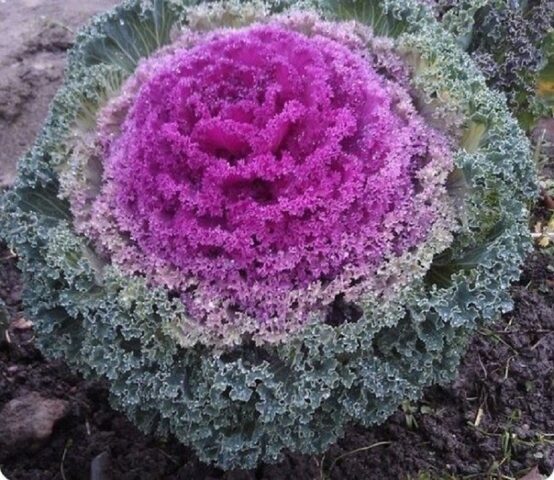
Robin

Lark tongue

Kai and Gerda

Sunrise F1 (Sunrise)

Lace frill F1 (Lace frill)

Piglon

Tokyo

Peacock

Lace mosaic

Nagoya mix

Assol
Conclusion
Numerous varieties of cauliflower differ from each other not only in the growing season, but also in the weight and color of the heads. All representatives have a rich chemical composition, which in terms of the range of useful minerals and vitamins significantly exceeds the usual white cabbage. The culture is also represented by plants with decorative shapes and exotic colors.



